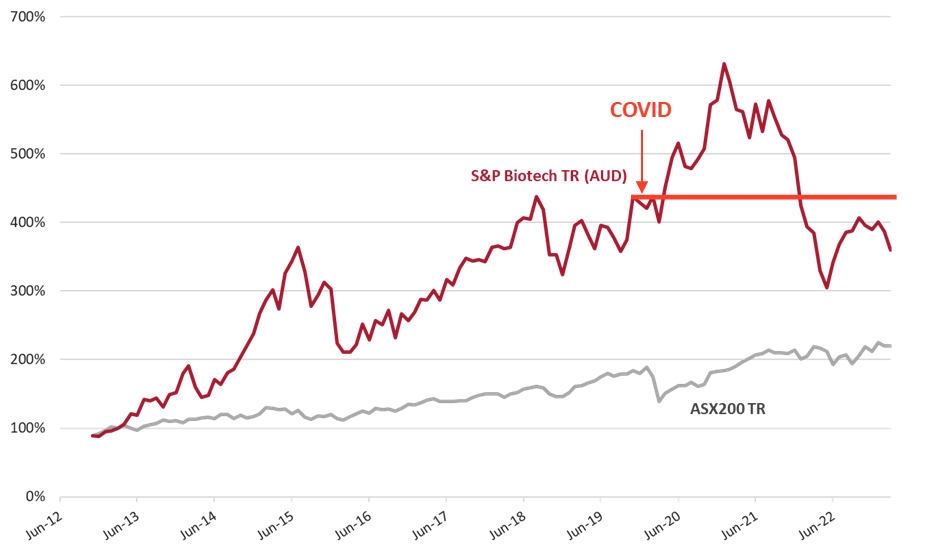Global Biotech – a market on sale with solid fundamentals
Global
Biotech is currently enduring one of the most protracted downturns in its history,
currently trading around 50% off its peak in mid-February 2021. Almost
inconceivably, when you consider the value delivered to the world in the form
of COVID vaccines, the biotech index is currently trading below pre-COVID
levels. This is despite a rally in the second half of CY2022, the overall
market gains of which have largely been given back in the first quarter of 2023.
Moreover, prior to the last two calendar years, there have never been 2
consecutive years of negative returns from the biotech index.

10 year returns of
the ASX200 (TR) and S&P Biotechnology Select Index (AUD) to 31 March
2023. Over this period the ASX200 has
delivered 8.2% p.a. while the Biotech Index has returned 13.6% p.a.
Why is this the Case?
Biotech companies can be characterised as cash-hungry entities developing assets (drugs / devices) that will only turn a profit in the future and, as such, are typically valued on their future cashflows. Consequently, the current monetary tightening cycle has negatively impacted the prices of growth companies almost indiscriminately, whether they be high growth tech or biotechnology companies.
However, unlike the tech sector whose end products are more closely linked to discretionary spend, biotechnology is inextricably linked to healthcare, which is notoriously resilient to economic downturns. As populations continue to age and chronic diseases become more prevalent, demand for innovative healthcare solutions will continue to rise. This demand supports biotech companies that are developing novel therapies and medical devices, leading to potential long-term growth opportunities. And most importantly, this underlying demand has nothing to do with economic cycles.
The
Global Biotech sector is currently inexpensive.
Just because prices have gone down, doesn’t necessarily mean something is cheap. However, as an indicator of how the biotech sector is currently inexpensive, back in May 2022 (the previous low of this current market downturn) there were 125 NASDAQ-listed small to mid cap (SMID cap) companies trading at or below cash backing. Historically there are only a dozen or so companies trading at this level. Updating these figures for March 2023, of the 488 NASDAQ-listed SMID cap companies, 102 (21%) of these are trading at or below cash backing (i.e. an Enterprise Value of zero, or even negative).
It's a Stock Picker's Market.
With so many companies trading close to zero enterprise value, this limits the theoretical downside scenario, making this an ideal stock-picker’s market. So how do you play this opportunity? Firstly, because the underlying risk of investing in a single biotech company is relatively high, it is always sensible to invest in a portfolio of biotech companies, not just one.
Secondly, in the current economic climate where access to funding may be more difficult, it is wise to seek companies with sufficient cash balances to fund operations well beyond stock-moving catalysts such a clinical trial read-outs. We always have a very healthy focus on capital adequacy when selecting our portfolio companies – a focus that has, and continues to, serve us well during the current market downturn.
Thirdly, while we would usually seek to screen investment opportunities predominantly on risk / reward characteristics, agnostic to the level of cash backing (although we always seek companies with adequate cash runway), with so many companies currently trading close to zero enterprise value, with limited downside risk, this makes the risk / reward dynamics of these opportunities extremely compelling.
The table below indicates the two main markets we play in: ASX and NASDAQ. Red indicates companies with inadequate cash reserves (less than 12 months) which we tend to avoid. Ideally we are seeking companies in Green with greater than 2 years cash reserves so they do not need to raise more (highly dilutive) capital at these currently depressed prices.

Cash
runway of ASX and NASDAQ small to mid cap (SMID) biotech companies. SMID cap
defined as companies with a market cap greater than $50m but less than $5b (in
local currency). Source: Factset and HB Biotechnology Analysis
While there are a handful of ASX biotech stocks that meet our minimum selection criteria of >1 year cash runway, there are 137 NASDAQ-listed biotech companies that meet this criterion AND their current market capitalisation is at least 75% backed by cash. In other words, assuming your downside scenario is the value of cash held, the maximum downside movement is 25%. This compares favourably with the typical near-term upside scenario (30% - 50%+) of most biotechnology companies, noting that longer term upside scenarios can easily be many multiples of your original investment.
A couple of comments about this very high level analysis:
- Just because there are no ASX biotech stocks that meet the 75% cash-backed AND >1 year cash backing criteria, doesn’t mean there aren’t compelling risk-reward opportunities - there just aren’t as many of them (and one of the reasons we invest globally, not just locally).
- There can be very good reasons that some of these 137 NASDAQ-listed companies are trading near or below cash backing. These can include poor data read-outs; no near-term stock moving catalysts; a high cash burn rate; or a combination of all the above. i.e. stock selection is still very important.
What we can see is that with prices currently depressed in the biotech sector, there are excellent opportunities to pick stocks with limited downside risk and a high potential for re-rating on fundamentals should these companies produce good clinical data. To be clear, making sure you pick companies with good assets and excellent management is still critically important, however the current market prices mean the number of opportunities that are also “good investments” (i.e. favourable risk / reward characteristics) is higher than usual: A Stock Picker’s Market.
So while we don’t know when the biotech market
will rebound from its current lows, what we do know is that the current downturn won’t
last forever and it is currently presenting some highly compelling
stock-picking opportunities. History has
also taught us that when the market does turn, it typically rebounds quickly, and
it pays to have your portfolio set.

